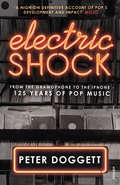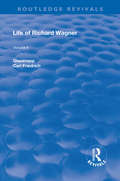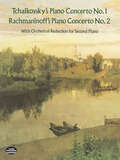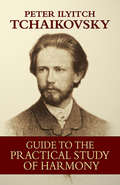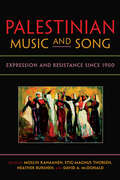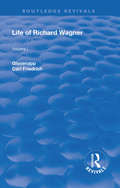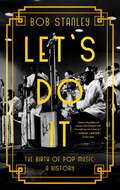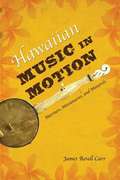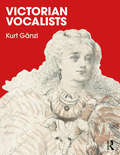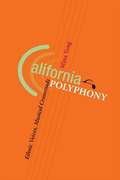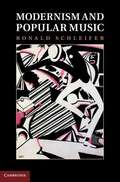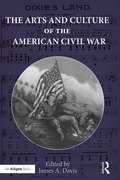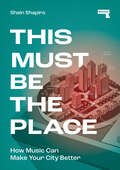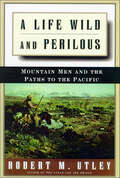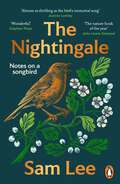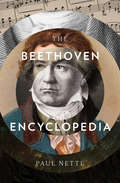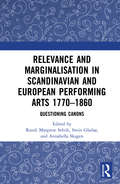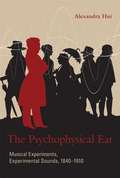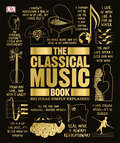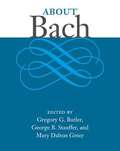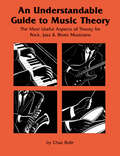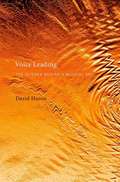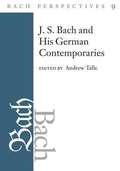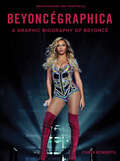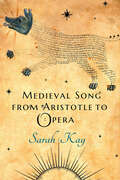- Table View
- List View
Electric Shock: From the Gramophone to the iPhone – 125 Years of Pop Music
by Peter DoggettAmbitious and groundbreaking, Electric Shock tells the story of popular music, from the birth of recording in the 1890s to the digital age, from the first pop superstars of the twentieth century to the omnipresence of music in our lives, in hit singles, ringtones and on Spotify. Over that time, popular music has transformed the world in which we live. Its rhythms have influenced how we walk down the street, how we face ourselves in the mirror, and how we handle the outside world in our daily conversations and encounters. It has influenced our morals and social mores; it has transformed our attitudes towards race and gender, religion and politics. From the beginning of recording, when a musical performance could be preserved for the first time, to the digital age, when all of recorded music is only a mouse-click away; from the straitlaced ballads of the Victorian era and the ‘coon songs’ that shocked America in the early twentieth century to gangsta rap, death metal and the multiple strands of modern dance music: Peter Doggett takes us on a rollercoaster ride through the history of music. Within a narrative full of anecdotes and characters, Electric Shock mixes musical critique with wider social and cultural history and shows how revolutionary changes in technology have turned popular music into the lifeblood of the modern world.
Revival: Opera and Drama (Routledge Revivals)
by Carl Friedrich GlasenappThe second volume of Carl Friedrich Glasenapp's Life of Richard Wagner.
Tchaikovsky's Piano Concerto No. 1 & Rachmaninoff's Piano Concerto No. 2: With Orchestral Reduction for Second Piano (Dover Classical Piano Music: Four Hands)
by Serge Rachmaninoff Peter Ilyitch TchaikovskyThis authoritative edition continues Dover's series of great piano concertos with orchestral reduction for second piano -- the universal standard, for students and professionals alike, for learning and rehearsing all concertos. Together for the first time are two of the most performed and recorded concertos of all time: the Tchaikovsky Piano Concerto No. 1 in G-flat Minor, Op. 23, and the Rachmaninoff Piano Concerto No. 2 in C Minor, Op. 18.Both of these great Russian works have achieved unrivaled worldwide popularity and are absolute musts in the repertoire of every serious pianist. The Tchaikovsky concerto combines a virtuoso piano part with brilliant orchestral scoring. The Rachmaninoff concerto is universally admired for the dark, brooding opening, enormously popular themes, and passionate, lyrical final movement. Every pianist and serious piano student will want this attractive and modestly priced edition.
Guide to the Practical Study of Harmony (Dover Books on Music)
by Peter Ilyitch TchaikovskyWritten during Tchaikovsky’s years as professor at the renowned Moscow Conservatory, this volume presents a clear and thorough introduction to the study of harmony. The great Russian composer expounded upon his views of music while he was in the full flower of his creative powers, offering students a chance to learn the discipline’s fundamentals from one of its great masters. Out of print for decades and exceedingly rare in its original edition, Tchaikovsky’s Guide to the Practical Study of Harmony possesses an intrinsic historical interest, yet remains as useful and instructive today as it was a century ago. A complete course in writing music, this excellent manual features numerous examples and exercises. It functions equally well as a classroom text, an adjunct to private instruction, or as a guide to individual musicians.
Palestinian Music and Song: Expression And Resistance Since 1900 (Public Cultures Of The Middle East And North Africa Ser.)
by David A. Mcdonald Stig-Magnus Thorsén Heather Bursheh Moslih KanaanehDrawing from a long history of indigenous traditions and incorporating diverse influences of surrounding cultures, music in Palestine and among the millions of Palestinians in diaspora offers a unique window on cultural and political events of the past century. From the perspective of scholars, performers, composers, and activists, Palestinian Music and Song examines the many ways in which music has been a force of representation, nation building, and social action. From the turn of the 20th century, when Palestine became an exotic object of fascination for missionaries and scholars, to 21st-century transnational collaborations in hip hop and new media, this volume traces the conflicting dynamics of history and tradition, innovation and change, power and resistance.
Revival: The Art Work of the Future (Routledge Revivals)
by Carl Friedrich GlasenappThis volume brings our story down to 1843, an important era in Richard Wagner’s Life, with his entry, as composer, of two successful operas, upon a so-called "practical" career at one of the principal German theatres.
Let's Do It: The Birth of Pop Music: A History
by Bob StanleyThe must-read music book of 2022—and the first such history bringing together all musical genres to tell the definitive narrative of the birth of Pop—from 1900 to the mid-1950s.Pop music didn't begin with the Beatles in 1963, or with Elvis in 1956, or even with the first seven-inch singles in 1949. There was a pre-history that went back to the first recorded music, right back to the turn of the century. Who were these earliest record stars—and were they in any meaningful way "pop stars"? Who was George Gershwin writing songs for? Why did swing, the hit sound for a decade or more, become almost invisible after World War II? The prequel to Bob Stanley&’s celebrated Yeah! Yeah! Yeah!, this new volume is the first book to tell the definitive story of the birth of pop, from the invention of the 78 rpm record at the end of the nineteenth century to the beginnings of rock and the modern pop age. Covering superstars such as Louis Armstrong, Bessie Smith, Duke Ellington and Frank Sinatra, alongside the unheralded songwriters and arrangers behind some of our most enduring songs, Stanley paints an aural portrait of pop music's formative years in stunning clarity, uncovering the silver threads and golden needles that bind the form together. Bringing the eclectic, evolving world of early pop to life—from ragtime, blues and jazz to Broadway, country, crooning, and beyond—Let's Do It is essential reading for all music lovers. "An encyclopaedic introduction to the fascinating and often forgotten creators of Anglo-American hit music in the first half of the twentieth century."—Neil Tennant (The Pet Shop Boys)
Hawaiian Music in Motion: Mariners, Missionaries, and Minstrels (Music in American Life)
by James Revell CarrHawaiian Music in Motion explores the performance, reception, transmission, and adaptation of Hawaiian music on board ships and in the islands, revealing the ways both maritime commerce and imperial confrontation facilitated the circulation of popular music in the nineteenth century. James Revell Carr draws on journals and ships' logs to trace the circulation of Hawaiian song and dance worldwide as Hawaiians served aboard American and European ships. He also examines important issues like American minstrelsy in Hawaii and the ways Hawaiians achieved their own ends by capitalizing on Americans' conflicting expectations and fraught discourse around hula and other musical practices.
Victorian Vocalists
by Kurt GanzlVictorian Vocalists is a masterful and entertaining collection of 100 biographies of mid- to late-19th-century singers and stars. Kurt Gänzl paints a vivid picture of the Victorian operatic and concert world, revealing the backgrounds, journeys, successes, failures and misdemeanours of these singers. This volume is not only an outstanding reference work for anyone interested in vocalists of the era, but also a compelling, meticulously researched picture of life in the vast shark tank that was Victorian music.
California Polyphony: Ethnic Voices, Musical Crossroads (Music in American Life)
by Mina YangWhat does it mean to be "Californian"? California Polyphony: Ethnic Voices, Musical Crossroads suggests an answer that lies at the intersection of musicology, cultural history, and politics. Consisting of a series of musical case studies of major ethnic groups in California, this book approaches the notion of Californian identity from diverse perspectives, each nuanced by class, gender, and sexuality. In the early twentieth century, the concept of the Pacific Rim and an orientalist fascination with Asian music and culture dominated the popular imagination of white Californians, influencing their interactions with the Asian Other. Several decades later, as tensions rose between the Los Angeles Police Department and the African American community, the once-thriving jazz and blues nightclub scene of 1940s Central Avenue became a primary target for law enforcement's anti-vice crusade. The reactionary nature of the musical scores for Hollywood's noir films of the World War II and postwar eras negotiated the perceived demise of white female sexuality in the face of black culture and urban corruption. Mina Yang also considers Mexican Americans' conflicted assimilation into the white American mainstream from the early 1900s through the 1970s, as well as contemporary Korean Americans' struggles to express their cultural and national identities through hip-hop, a genre usually associated with African Americans. According to Yang, there has never been a straightforward definition of "Californian." This most populous and most affluent state in the Union has been setting musical and cultural trends for decades, and Yang's study thoughtfully illuminates the multiculutral nature of its musics.
Modernism and Popular Music
by Ronald SchleiferTraditionally, ideas about twentieth-century 'modernism' - whether focused on literature, music or the visual arts - have made a distinction between 'high' art and the 'popular' arts of best-selling fiction, jazz and other forms of popular music, and commercial art of one form or another. In Modernism and Popular Music, Ronald Schleifer instead shows how the music of George and Ira Gershwin, Cole Porter, Thomas 'Fats' Waller and Billie Holiday can be considered as artistic expressions equal to those of the traditional high art practices in music and literature. Combining detailed attention to the language and aesthetics of popular music with an examination of its early twentieth-century performance and dissemination through the new technologies of the radio and phonograph, Schleifer explores the 'popularity' of popular music in order to reconsider received and seeming self-evident truths about the differences between high art and popular art and, indeed, about twentieth-century modernism altogether.
The Arts and Culture of the American Civil War
by James A. DavisIn 1864, Union soldier Charles George described a charge into battle by General Phil Sheridan: "Such a picture of earnestness and determination I never saw as he showed as he came in sight of the battle field . . . What a scene for a painter!" These words proved prophetic, as Sheridan’s desperate ride provided the subject for numerous paintings and etchings as well as songs and poetry. George was not alone in thinking of art in the midst of combat; the significance of the issues under contention, the brutal intensity of the fighting, and the staggering number of casualties combined to form a tragedy so profound that some could not help but view it through an aesthetic lens, to see the war as a concert of death. It is hardly surprising that art influenced the perception and interpretation of the war given the intrinsic role that the arts played in the lives of antebellum Americans. Nor is it surprising that literature, music, and the visual arts were permanently altered by such an emotional and material catastrophe. In The Arts and Culture of the American Civil War, an interdisciplinary team of scholars explores the way the arts – theatre, music, fiction, poetry, painting, architecture, and dance – were influenced by the war as well as the unique ways that art functioned during and immediately following the war. Included are discussions of familiar topics (such as Ambrose Bierce, Peter Rothermel, and minstrelsy) with less-studied subjects (soldiers and dance, epistolary songs). The collection as a whole sheds light on the role of race, class, and gender in the production and consumption of the arts for soldiers and civilians at this time; it also draws attention to the ways that art shaped – and was shaped by – veterans long after the war.
This Must Be the Place: How Music Can Make Your City Better
by Shain ShapiroThis Must Be the Place explores how music can make cities better.This Must Be the Place introduces and examines music&’s relationship to cities. Not the influence cities have on music, but the powerful impact music can have on how cities are developed, built, managed and governed.Told in an accessible way through personal stories from cities around the world — including London, Melbourne, Nashville, Austin and Zurich — This Must Be the Place takes a truly global perspective on the ways music is integral to everyday life but neglected in public policy.Arguing for the transformative role of artists and musicians in a post-pandemic world, This Must Be The Place not only examines the powerful impact music can have on our cities, but also serves as a how-to guide and toolkit for music-lovers, artists and activists everywhere to begin the process of reinventing the communities they live in.
A Life Wild and Perilous: Mountain Men and the Paths to the Pacific
by Robert M. UtleyEarly in the nineteenth century, the mountain men emerged as a small but distinctive group whose knowledge and experience of the trans-Mississippi West extended the national consciousness to continental dimensions. Though Lewis and Clark blazed a narrow corridor of geographical reality, the West remained largely terra incognita until trappers and traders--Jim Bridger, Kit Carson, Tom Fitzpatrick, Jedediah Smith--opened paths through the snow-choked mountain wilderness. They opened the way west to Fremont and played a major role in the pivotal years of 1845-1848 when Texas was annexed, the Oregon question was decided, and the Mexican War ended with the Southwest and California in American hands, the Pacific Ocean becoming our western boundary.
The Nightingale: ‘The nature book of the year’
by Sam Lee'Wondering and wonderful. The nature book of the year.' JOHN LEWIS-STEMPEL'This lovely book is almost as thrilling as the bird's immortal song - balm for a troubled soul and a glimpse of paradise.' JOANNA LUMLEY______________________________Come to the forest, sit by the fireside and listen to intoxicating song, as Sam Lee tells the story of the nightingale.Every year, as darkness falls upon woodlands, the nightingale heralds the arrival of Spring. Throughout history, its sweet song has inspired musicians, writers and artists around the world, from Germany, France and Italy to Greece, Ukraine and Korea. Here, passionate conservationist, renowned musician and folk expert Sam Lee tells the story of the nightingale. This book reveals in beautiful detail the bird's song, habitat, characteristics and migration patterns, as well as the environmental issues that threaten its livelihood.From Greek mythology to John Keats, to Persian poetry and 'A Nightingale Sang in Berkeley Square', Lee delves into the various ways we have celebrated the nightingale through traditions, folklore, music, literature, from ancient history to the present day. The Nightingale is a unique and lyrical portrait of a famed yet elusive songbird.______________________________'Sam Lee has brought the poetic magic that has long enchanted so many of his musical fans into the written word. Allow yourself to glimpse the world Sam sees, to be part of his love affair with the nightingale, and you will no doubt be delighted.' LILY COLE'A wonderful book.' STEPHEN MOSS'A magical marriage of the lyrical and practical: a book that makes us want to seek out the nightingale and then reveals how we can.' TRISTAN GOOLEY
The Beethoven Encyclopedia
by Paul NettlThis comprehensive A-to-Z reference is comprised of detailed and authoritative entries on every aspect of the great composer&’s life. Ludwig van Beethoven is one of the most famous and revered composers in classical music. His instantly recognizable concertos and symphonies continue to be among the most performed by symphonies across the globe. In this definitive reference volume, eminent musicologist Paul Nettl provides students and researchers with an in-depth biographical resource organized in alphabetical entries. The Beethoven Encyclopedia covers the German composer&’s music, personal life, and patrons, among other topics, such as the forces that inspired his genius.
Relevance and Marginalisation in Scandinavian and European Performing Arts 1770–1860: Questioning Canons
by Randi Margrete SelvikRelevance and Marginalisation in Scandinavian and European Performing Arts 1770–1860: Questioning Canons reveals how various cultural processes have influenced what has been included, and what has been marginalised from canons of European music, dance, and theatre around the turn of the nineteenth century and the following decades. This collection of essays includes discussion of the piano repertory for young ladies in England; canonisation of the French minuet; marginalisation of the popular German dramatist Kotzebue from the dramatic canon; dance repertory and social life in Christiania (Oslo); informal cultural activities in Trondheim; repertory of Norwegian musical clocks; female itinerant performers in the Nordic sphere; preconditions, dissemination, and popularity of equestrian drama; marginalisation and amateur staging of a Singspiel by the renowned Danish playwright Oehlenschläger, also with perspectives on the music and its composers; and the perceived relevance of Henrik Ibsen’s staged theatre repertory and early dramas. By questioning established notions about canon, marginalisation, and relevance within the performing arts in the period 1770–1860, this book asserts itself as an intriguing text both to the culturally interested public and to scholars and students of musicology, dance research, and theatre studies.
The Psychophysical Ear
by Alexandra HuiIn the middle of the nineteenth century, German and Austrian concertgoers began to hear new rhythms and harmonies as non-Western musical ensembles began to make their way to European cities and classical music introduced new compositional trends. At the same time, leading physicists, physiologists, and psychologists were preoccupied with understanding the sensory perception of sound from a psychophysical perspective, seeking a direct and measurable relationship between physical stimulation and physical sensation. These scientists incorporated specific sounds into their experiments--the musical sounds listened to by upper middle class, liberal Germans and Austrians. In The Psychophysical Ear, Alexandra Hui examines this formative historical moment, when the worlds of natural science and music coalesced around the psychophysics of sound sensation, and new musical aesthetics were interwoven with new conceptions of sound and hearing. Hui, a historian and a classically trained musician, describes the network of scientists, musicians, music critics, musicologists, and composers involved in this redefinition of listening. She identifies a source of tension for the psychophysicists: the seeming irreconcilability between the idealist, universalizing goals of their science and the increasingly undeniable historical and cultural contingency of musical aesthetics. The convergence of the respective projects of the psychophysical study of sound sensation and the aesthetics of music was, however, fleeting. By the beginning of the twentieth century, with the professionalization of such fields as experimental psychology and ethnomusicology and the proliferation of new and different kinds of music, the aesthetic dimension of psychophysics began to disappear.
The Classical Music Book: Big Ideas Simply Explained (DK Big Ideas)
by DKLearn about the world&’s greatest classical compositions and musical traditions in The Classical Music Book.Part of the fascinating Big Ideas series, this book tackles tricky topics and themes in a simple and easy to follow format. Learn about Classic Music in this overview guide to the subject, great for novices looking to find out more and experts wishing to refresh their knowledge alike! The Classical Music Book brings a fresh and vibrant take on the topic through eye-catching graphics and diagrams to immerse yourself in. This captivating book will broaden your understanding of Classical Music, with:- More than 90 pieces of world-famous music - Packed with facts, charts, timelines and graphs to help explain core concepts- A visual approach to big subjects with striking illustrations and graphics throughout- Easy to follow text makes topics accessible for people at any level of understandingThe Classical Music Book is a captivating introduction to music theory, crucial composers and the impact of seminal pieces, aimed at adults with an interest in the subject and students wanting to gain more of an overview. Here you&’ll discover more than 90 works by famous composers from the early period to the modern day, through exciting text and bold graphics.Your Classical Music Questions, Simply ExplainedFrom Mozart to Mendelssohn, this fresh new guide goes beyond your typical music books, offering a comprehensive overview to classical music history and biography. If you thought it was difficult to learn about music theory, The Classical Music Book presents key information in an easy to follow layout. Explore the main ideas underpinning the world&’s greatest compositions and musical traditions, and define their importance to the musical canon and into their wider social, cultural, and historical context.The Big Ideas SeriesWith millions of copies sold worldwide, The Classical Music Book is part of the award-winning Big Ideas series from DK. The series uses striking graphics along with engaging writing, making big topics easy to understand.
About Bach
by Mary Dalton Greer Gregory S Butler George StaufferThat Johann Sebastian Bach is a pivotal figure in the history of Western music is hardly news, and the magnitude of his achievement is so immense that it can be difficult to grasp. In About Bach, fifteen scholars show that Bach's importance extends from choral to orchestral music, from sacred music to musical parodies, and also to his scribes and students, his predecessors and successors. Further, the contributors demonstrate a diversity of musicological approaches, ranging from close studies of Bach's choices of musical form and libretto to wider analyses of the historical and cultural backgrounds that impinged upon his creations and their lasting influence. This volume makes significant contributions to Bach biography, interpretation, pedagogy, and performance. Contributors are Gregory G. Butler, Jen-Yen Chen, Alexander J. Fisher, Mary Dalton Greer, Robert Hill, Ton Koopman, Daniel R. Melamed, Michael Ochs, Mark Risinger, William H. Scheide, Hans-Joachim Schulze, Douglass Seaton, George B. Stauffer, Andrew Talle, and Kathryn Welter.
An Understdable Guide to Music Theory: The Most Useful Aspects of Theory for Rock, Jazz, and Blues Musicians
by Chaz BufeThis guide explains the most useful aspects of theory in clear, nontechnical language. Areas covered include scales (major, minor, modal, synthetic), chord formation, chord progression, melody, song forms, useful devices, (ostinato, mirrors, hocket, etc.), and instrumentation. It contains over 100 musical examples.
Voice Leading: The Science behind a Musical Art
by David HuronVoice leading is the musical art of combining sounds over time. In this book, David Huron offers an accessible account of the cognitive and perceptual foundations for this practice. Drawing on decades of scientific research, including his own award-winning work, Huron offers explanations for many practices and phenomena, including the perceptual dominance of the highest voice, chordal-tone doubling, direct octaves, embellishing tones, and the musical feeling of sounds "leading" somewhere. Huron shows how traditional rules of voice leading align almost perfectly with modern scientific accounts of auditory perception. He also reviews pertinent research establishing the role of learning and enculturation in auditory and musical perception.Voice leading has long been taught with reference to Baroque chorale-style part-writing, yet there exist many more musical styles and practices. The traditional emphasis on Baroque part-writing understandably leaves many musicians wondering why they are taught such an archaic and narrow practice in an age of stylistic diversity. Huron explains how and why Baroque voice leading continues to warrant its central pedagogical status. Expanding beyond choral-style writing, Huron shows how established perceptual principles can be used to compose, analyze, and critically understand any kind of acoustical texture from tune-and-accompaniment songs and symphonic orchestration to jazz combo arranging and abstract electroacoustic music. Finally, he offers a psychological explanation for why certain kinds of musical textures are more likely to be experienced by listeners as pleasing.
Bach Perspectives, Volume 9: J.S. Bach and His Contemporaries in Germany
by Andrew TalleThis provocative addition to the Bach Perspectives series offers a counternarrative to the isolated genius status that J.S. Bach and his music currently enjoy. Contributors contextualize Bach by examining the output, reputation, and compositional practices of his contemporaries in Germany whose work was widely played and enjoyed in his time, including Georg Philipp Telemann, Christoph Graupner, Gottlieb Muffat, and Johann Adolf Scheibe. Essays place Bach and his work in relation to his peers, examining avenues of composition they took while he did not and showing how differing treatments of the same subjects or texts resulted in markedly different compositional results and legacies. By looking closely at how Bach's contemporaries addressed the tasks and challenges of their time, this project provides a more nuanced view of the musical world of Bach's time while revealing in more specific terms than ever how and why Bach's own music remains fresh and compelling. Contributors are Alison Dunlop, Wolfgang Hirschmann, Michael Maul, Andrew Talle, and Steven Zohn.
Beyoncégraphica: A Graphic Biography of Beyoncé
by Chris RobertsAn easy-to-read biography of “the most important and compelling popular musician of the twenty-first century,” includes infographics and photos (TheNew Yorker).Beyoncé needs no introduction. Singer, artist, activist and icon, she is worshiped by her many fans around the word.This stunning graphic biography tells the story of how a young singer from Texas transformed into a global superstar, celebrating the highlights and successes of her career through stunning new graphics, photographs and illustrations. Representing so much more than the pop industry, through philanthropy, politics and campaigning, Beyoncé has broken the mould of what it means to be a superstar—and that star just continues to rise.From costume changes to record sales, her impressive vocal range to her work off-stage, this original bio-graphic book charts the success of the icon who came to dominate the charts, our screens and even our wardrobes. An absolute must for any “Beehive” members and Beyoncé fans.
Medieval Song from Aristotle to Opera
by Sarah KayFocusing on songs by the troubadours and trouvères from the twelfth to the fourteenth centuries, Medieval Song from Aristotle to Opera contends that song is not best analyzed as "words plus music" but rather as a distinctive way of sounding words. Rather than situating them in their immediate period, Sarah Kay fruitfully listens for and traces crosscurrents between medieval French and Occitan songs and both earlier poetry and much later opera. Reflecting on a song's songlike quality—as, for example, the sound of light in the dawn sky, as breathed by beasts, as sirenlike in its perils—Kay reimagines the diversity of songs from this period, which include inset lyrics in medieval French narratives and the works of Guillaume de Machaut, as works that are as much desired and imagined as they are actually sung and heard. Kay understands song in terms of breath, the constellations, the animal soul, and life itself. Her method also draws inspiration from opera, especially those that inventively recreate medieval song, arguing for a perspective on the manuscripts that transmit medieval song as instances of multimedia, quasi-operatic performances. Medieval Song from Aristotle to Opera features a companion website (cornellpress.manifoldapp.org/projects/medieval-song) hosting twenty-four audio or video recordings, realized by professional musicians specializing in early music, of pieces discussed in the book, together with performance scores, performance reflections, and translations of all recorded texts. These audiovisual materials represent an extension in practice of the research aims of the book—to better understand the sung dimension of medieval song.
